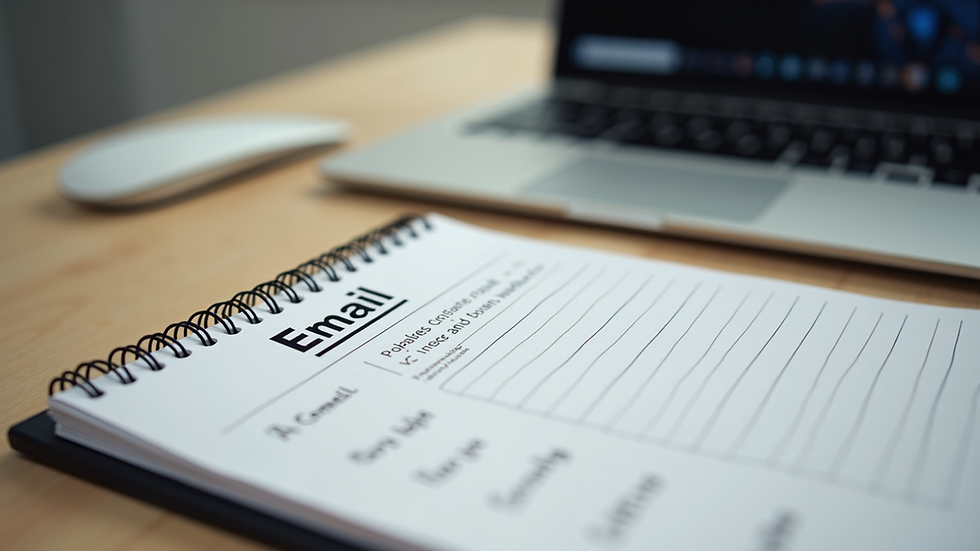Crafting the Perfect Business Email Contact
- Alex Zemianek

- Sep 22
- 4 min read
In today's fast-paced digital world, crafting the perfect professional business email contact is essential for effective communication. Whether you are reaching out to potential clients, partners, or colleagues, your email sets the tone for your relationship. A well-written email can open doors, build trust, and create opportunities. This guide will walk you through the key elements of creating a professional business email that stands out and gets results.
Understanding the Importance of a Professional Business Email
A professional business email is more than just a message; it is a reflection of your brand and professionalism. When you send an email, the recipient forms an impression of you and your business within seconds. This impression can influence their willingness to engage with you further.
Key reasons why a professional business email matters:
Builds credibility: A clear and polite email shows you respect the recipient’s time.
Enhances clarity: Well-structured emails reduce misunderstandings.
Encourages response: A concise and relevant message increases the chances of a reply.
Represents your brand: Consistent tone and style reinforce your business identity.
To create a professional business email, focus on clarity, tone, and structure. Use a professional email address that includes your company domain rather than generic providers like Gmail or Yahoo. This small detail adds authenticity and trustworthiness.

How to Write a Professional Business Email
Writing a professional business email involves several important steps. Here’s a practical approach to ensure your email is effective and polished:
1. Use a Clear Subject Line
The subject line is the first thing your recipient sees. It should be concise and informative, giving a clear idea of the email’s purpose.
Avoid vague subjects like "Hello" or "Question."
Use specific phrases like "Meeting Request for Project Update" or "Proposal Submission Deadline."
2. Start with a Proper Greeting
Address the recipient respectfully. Use their name if you know it, or a formal title if you don’t.
Examples: "Dear Mr. Khan," "Hello Ms. Ahmed," or "Greetings."
3. Write a Concise and Relevant Body
Keep your message focused. Use short paragraphs and bullet points to improve readability.
Introduce yourself briefly if necessary.
State the purpose of your email early.
Provide any necessary details or context.
End with a clear call to action or next steps.
4. Use a Professional Closing
End your email politely with phrases like:
"Best regards,"
"Sincerely,"
"Thank you for your time,"
Follow this with your full name, position, and contact information.
5. Proofread Before Sending
Check for spelling, grammar, and punctuation errors. A mistake-free email reflects attention to detail.
Example Email Template
```
Subject: Request for Collaboration Meeting
Dear Ms. Ahmed,
I hope this message finds you well. I am writing to discuss a potential collaboration between our companies. We believe that working together could bring mutual benefits.
Could we schedule a meeting next week to explore this opportunity? Please let me know your availability.
Thank you for considering this request.
Best regards,
Ali Raza
Business Development Manager
ali.raza@company.com
+92 300 1234567
```

Is info@ a Business Email?
Many businesses use generic email addresses like info@company.com for general inquiries. But is info@ a business email? The answer depends on the context and purpose.
Pros of Using info@ Emails
Centralized communication: All inquiries go to one inbox, making it easier to manage.
Professional appearance: It looks official and is easy to remember.
Accessible: Customers know where to send general questions.
Cons of Using info@ Emails
Impersonal: It lacks a personal touch, which can reduce engagement.
Risk of delays: If many people access the inbox, responses might be slower.
Spam target: Generic addresses often receive more spam.
Best Practices for info@ Emails
Assign a dedicated team member to monitor and respond promptly.
Use auto-responders to acknowledge receipt and set expectations.
Forward specific queries to relevant departments quickly.
While info@ can be useful, for personalized communication, using individual email addresses with names is often more effective.

Tips for Maintaining a Professional Business Email Contact
Maintaining a professional business email contact goes beyond writing the initial message. It involves ongoing communication practices that build and sustain relationships.
1. Respond Promptly
Aim to reply within 24 hours. Timely responses show respect and professionalism.
2. Keep Emails Organized
Use folders and labels to manage your inbox efficiently. This helps you track conversations and follow up when needed.
3. Personalize Your Messages
Whenever possible, tailor your emails to the recipient. Mention previous interactions or specific details to show genuine interest.
4. Use Clear and Consistent Signatures
Include your full name, position, company name, phone number, and website link. This makes it easy for recipients to contact you.
5. Avoid Overuse of Jargon
Use simple language to ensure your message is understood by all recipients, regardless of their background.
6. Respect Privacy and Confidentiality
Use BCC when sending to multiple recipients to protect their email addresses. Avoid sharing sensitive information unless necessary.
By following these tips, you can maintain a strong and professional business email contact that fosters trust and collaboration.
Enhancing Your Business Communication with the Right Contact Link
Providing an easy way for clients and partners to reach you is crucial. Embedding a clear and accessible business email contact link on your website or email signature encourages communication and builds credibility.
Make sure your contact page is user-friendly, with multiple options such as email, phone, and contact forms. This flexibility caters to different preferences and increases the likelihood of engagement.
Crafting the perfect professional business email contact is a skill that can significantly impact your business relationships. By focusing on clarity, professionalism, and responsiveness, you can create emails that open doors and build lasting connections. Remember, your email is often the first impression you make - make it count.




Comments